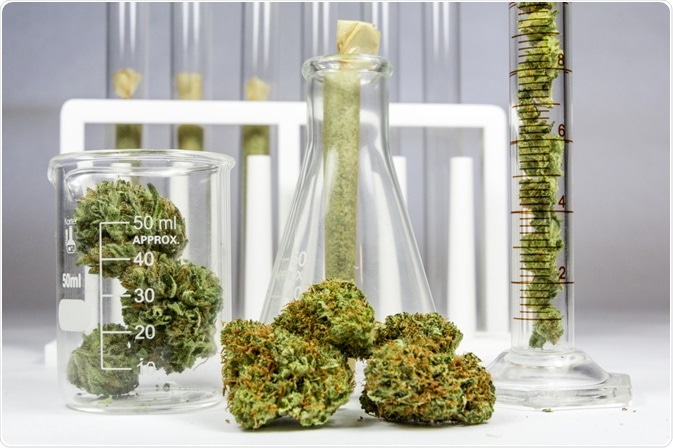For most of history, cannabis use has been legal. It was recently, during the 20th century when bills were passed to prohibit the use of the drug in countries around the world.

Cannabis Analysis. Image Credit: Mitch M/Shutterstock.com
Now, attitudes towards cannabis have drastically changed, partly due to research that has uncovered the medicinal benefit of cannabis use for alleviating symptoms of several illnesses. As of June 2020, just under 50 countries had legalized cannabis for medicinal, recreational, or both purposes, along with 35 states. More countries and states are continuing to revise their legislature on the use of the drug and legalization is expected to continue to happen over the coming years.
Legalization has facilitated a surge in available cannabis-based products that has led to high demand for testing methods capable of ensuring the quality and safety of the product. Particularly, cannabis producers are required to test for contaminants in their product, such as heavy metals that are taken up through the roots from the soil as the plant grows.
Heavy metals can also be introduced into the plant via fertilizers and growing mediums. Measuring the levels of these heavy metals in cannabis products is considered almost as important as measuring the THC and CDB levels. Here, we discuss the currently used methods of measuring heavy metals in cannabis.
Why do we need to limit exposure to heavy metals?
Exposure to heavy metals has been linked to severe acute and chronic health impacts. Over the long-term, exposure to heavy metals can cause irreversible damage to the body. The literature highlights that muscular, physical, and neurological degeneration can be the effect of such exposure. The processes involved in heavy metal exposure-induced degeneration has been liked to those involved in neurodegenerative diseases such as Alzheimer's disease, Parkinson's disease, multiple sclerosis, and muscular dystrophy.
Due to the potentially severe effects of heavy metal exposure, it is vital to control these elements in cannabis to protect people from harm.
Heavy metal analysis
In the US, producers of cannabis products must comply with regulations that limit the levels of four major heavy metals including arsenic, cadmium, lead, and mercury. Therefore, manufacturers must test their products to ensure that levels of these heavy metals do not exceed the stated limitations. The challenge is, accepted maximum levels are still considered to be relatively low, so analytical tests must be sensitive enough to reliably and accurately detect and measure small quantities of these elements.
The most common method used by cannabis testing labs in the US involves dissolving samples of the cannabis product involves combining microwave digestion with concentrated mineral acids. Hydrochloric acid, hydrogen peroxide, and nitric acid are mineral acids commonly used for this purpose.
In comparison with the traditional hot block digestion technique, microwave digestion has the advantages of achieving higher temperatures which typically reach 200°C or more, whereas the traditional hot block system reaches a peak of around 120°C.
Microwave digestion emits significant levels of carbon dioxide (CO2) and nitrogen dioxide (NO2) as they process cannabis samples, meaning that as well as accommodating the required high temperatures to digest the product, microwave digestion must also manage the increase in pressure generated by these large volumes of gas. Larger samples pose a challenge to the microwave technique as larger quantities produce larger volumes of gas.
Additionally, microwave digestion systems also face the challenge of having to segregate samples before introducing them into the microwave. To overcome this, scientists established a method of batching samples together based on matrices. However, this still required multiple samples to be run in parallel, with only one matrix able to be tested at a time.
Recently, researchers have developed an innovative method to optimize microwave digestion technology that overcomes this limitation. The updated technique incorporates recent advancements in sensor technology, temperature measurement and control, and vessel design.
In addition, advancements in software algorithms have allowed power levels to be optimized, facilitating individual adjustments to be made for different sample vessels. As a result, batch samples can contain various matrices and no longer have to be grouped together based on this factor, therefore, increasing the efficiency of the method.
The future of cannabis analysis
The use of cannabis for both medical and recreational purposes is being legalized around the world, with more countries and states planning to legalize it this year and in the following years. This is creating an entirely new commercial market that requires effective and reliable analytical techniques to ensure product safety.
Microwave digestion is a technique that can effectively analyze the levels of heavy metals in plant samples such as cannabis. Recent innovations have improved the efficiency of this method, making it likely to remain the common method for measuring heavy metals in cannabis.
Sources:
- Ćaćić, M., Perčin, A., Zgorelec, Ž. and Kisić, I., 2019. Evaluation of heavy metals accumulation potential of hemp (Cannabis sativa L.). Journal of Central European Agriculture, 20(2), pp.700-711. https://hrcak.srce.hr/index.php?show=clanak&id_clanak_jezik=323443
- McPartland, J. and McKernan, K., 2017. Contaminants of Concern in Cannabis: Microbes, Heavy Metals, and Pesticides. Cannabis sativa L. - Botany and Biotechnology, pp.457-474. https://link.springer.com/chapter/10.1007/978-3-319-54564-6_22
- Thomas, R., 2020. Measuring Heavy Metal Contaminants in Cannabis and Hemp. www.taylorfrancis.com/.../9781003004158
Further Reading